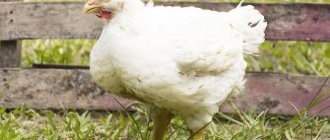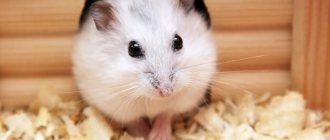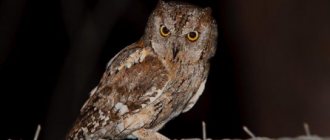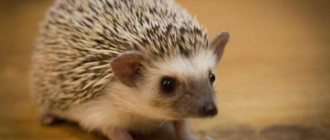Having made a deliberate decision to get a hamster at home, you must first make sure that your household members are not allergic to animal fur, choose the right place of residence for the future pet and study the rules for caring for it.
The hamster is a rather picky animal, but still requires careful care and attentive attitude towards itself.
What types of hamsters are there?
Rodents vary in color, size and coat type. There are five types of domestic hamsters in total. Their standards, The National Hamster Council, are set by the National Association of Hamster Fanciers of England.
Syrian hamster
This is the largest Syrian Hamsters from home. The average length of its body is 13 cm. Females are sometimes larger than males.
The classic color of the Syrian hamster is golden brown. There is black ticking on the back - this means that areas of different colors alternate on the hairs. The animal's belly is white with gray undercoat, and there are dark spots on its cheeks.
Individuals of other colors are often found: white, cream, brown, black, gold, silver-gray, striped.
Hamsters of this species can have different coats. There are four types in total:
- Short . The soft fur fits snugly to the body.
- Long . The length of the hairs is from 7.5 to 10 cm.
- Rex . The fur appears tousled.
- Satin . The hair has a glossy shine. It is not recommended to crossbreed two hamsters with such hair, because sometimes the offspring will be bald.
Syrian hamster with classic color. Photo: Olena Kurashova / Shutterstock
Campbell's Russian Hamster
The body length of such a rodent, Dwarf Exhibition Standards, is 10–12 cm. There are three main colors of the animal:
- Normal . The hairs on the back are brown. The belly is white with gray undercoat. The eyes are black.
- Argenta . The top layer of wool is orange-sand, the bottom is smoky-gray. The eyes are red.
- Albino . These are completely white pets with bright pink eyes.
Hamsters with gray, beige, black and chocolate fur are considered non-standard.
Campbell's Russian hamster with normal color. Photo: softkrafts.live.com/Depositphotos
Djungarian hamster
This Dwarf Exhibition Standards animal is sometimes called the Russian white dwarf hamster. Its body length is 8–10 cm. All pets of this species have a black stripe on their backs. There are only three colors:
- Normal . The body is dark brown, with black ticking on a third of the hairs. The paws and belly are white, and the ears are gray.
- Pearl . The rodent's fur is white.
- Sapphire . The fur on the back is smoky gray with a blue tint, the belly is white.
Sapphire colored Djungarian hamster. Photo: Faifarris4746/Shutterstock
Chinese hamster
This rodent looks like a mouse without a long tail. Its body length is 10–12 cm, weight is 45–50 g. There are two main colors of the Chinese Hamster animal:
- Normal . The back and sides are brown with a chestnut tint, the belly is white. A black stripe stretches from the forehead to the tail.
- Spotted . Most of the fur is white. There is an elongated brown spot along the spine.
Albinos with black eyes are extremely rare. They come in litters from spotted parents. But this is the exception rather than the rule.
Chinese hamster with normal color. Photo: alexvey/Shutterstock
Roborovsky's hamster
The smallest of domestic rodents. It weighs only 20–25 g, and its body length is 4.5–5 cm. Typically, these animals have golden-brown fur on their face and back. The roots of the hairs are gray, and there are light spots near the eyebrows. But very rarely there are hamsters with a white muzzle.
Roborovsky's hamster. Photo: Anyarnia/Shutterstock
Who are they?
In simple terms, hamsters are animals of the subfamily of rodents of the hamster family. They differ from their close relatives of mice in their small build, short tail process, small and rounded ears, as well as cheek pouches in which individuals of this species store and carry food.
The external characteristics of hamsters can vary significantly depending on the variety. Approximate description: body length from 5 to 30 centimeters, weight from 30 to 500 grams. Thanks to breeding research, the color is also varied - from solid white, blue, black and red shades to brown flowers with an original pattern on the back or chest.
In their natural environment, representatives of this breed can be found in many regions of Eurasia, China and Korea. These animals live mainly in open spaces of steppes and deserts.
Unlike their relatives, some types of hamsters can be trained and trained. In addition, like many other animal species, hamsters are capable of hibernating during periods of cold and lack of food.
What is the character of hamsters?
Rodents are active and curious Providing a Home for a Hamster. Animals are interesting to watch when they play in a cage. If a pet has been accustomed to communicating with a person since childhood, it can calmly sit in your arms. Hamsters rarely bite All About Syrian Hamsters: mainly when they are frightened by a sudden movement. Before communicating, for example, with Syriac, it is recommended to wash your hands. He has poor eyesight, so he relies on smell and touch. If the owner's fingers smell of food, the animal can taste them.
It is not worth keeping individuals in pairs. Even when they live together from an early age, conflicts can arise over time.
If you are still going to buy several animals, it is better to place them in different cages.
Keep in mind that rodents are nocturnal. They sleep during the day, so it is better to play with them in the evening. If you decide to wake up your All About Syrian Hamsters pet, do it very carefully. Talk to him in a gentle voice and lightly rustle the bedding in the cage.
Hygiene procedures
Like other furry pets, the hamster needs hygiene procedures. Long-haired individuals require daily care. It is important to regularly clean the skin from dirt.
Bathing
You can bathe pets only in exceptional cases, using a special shampoo. Water procedures are a stressful situation for animals, since they are quite clean and constantly wash themselves.
It is recommended to place a container with dry sand in the cage, in which the animal will clean its fur. When fleas appear, you should wash your hamster with an antiparasitic agent, applying it with gentle movements to the surface of the body.
Dry cleaning of fur.
Nail care
Particular attention should be paid to the claws. They need to be regularly ground down, because with a sedentary lifestyle and the onset of natural old age, they grow to such an extent that the hamster cannot walk normally.
What living conditions does a hamster require?
It is best to house your hamster in a spacious wire cage, Choosing a Dwarf Hamster Cage. The minimum floor area is 60 × 30 cm. A plastic tray is considered a good option. But grated flooring is not suitable: your pet will easily injure its paws on it. The door of the home must close tightly. The distance between the rods is no more than 5 mm. Otherwise, the rodent may escape.
If you choose a multi-level design, pay attention to the height of the floors. The lower they are, the better. Then, when falling, the animal will not be seriously injured.
A pet store may offer you a plastic cage with pipes. Keep in mind: it will not provide adequate ventilation. In addition, it will be difficult to clean.
Hamsters are susceptible to cold and heat. They feel best at a temperature of 18–21 °C The ideal home for your hamster. Therefore, the cage is usually placed away from drafts, radiators and direct sunlight. If the room is too cold, the animal may hibernate. Loud sounds and vibrations cause stress in rodents. Therefore, it is worth finding a calm and quiet place for the house. There should be no TV or music system nearby.
Be sure to place a ceramic bowl inside the cage How to Care for Your Pet Hamster, and pour water into the nipple drinker.
A large layer of bedding should be laid on the pallet of the dwelling. Animals love to rummage in it. If you want to go with wood How to Care for Your Pet Hamster litter, choose aspen. Cedar and pine irritate the respiratory tract of hamsters.
The cage should also have shelter. The pet will rest there. If desired, you can buy a wooden or plastic house. Some owners use cardboard boxes. They wear out quickly, but are easy to replace.
Running wheel without cross supports. Photo: PetroP/Depositphotos
A hamster definitely needs a large running wheel. Try to find something that attaches to the cage. Typically, such models do not have transverse supports on which the animal can damage its paws. If you are a light sleeper, choose a quiet design.
To grind down the teeth that hamsters constantly grow, you will need wooden toys from Pet Hamster Toys. But some owners simply give their pets toilet paper or towel rolls instead.
Ensuring activity
It is forbidden to keep a hamster in a miniature enclosure or a 3-liter jar. This will lead to a deterioration in his health and the development of various diseases.
Proper care involves organizing leisure time. Therefore, pet owners set up entire play complexes, labyrinths and tunnels where the animals spend all their free time.
Walking around the apartment is allowed only in a special ball. If this rule is not taken into account, the hamster may be in mortal danger: falling into a boiling pan, eating a plant containing toxic substances, chewing through an electrical wire, etc. It is quite difficult to catch him in the apartment.
It is forbidden to arrange walks on high surfaces, because there is a risk that the pet will fall.
Is it possible to walk outside
Some owners allow their hamster to roam outside. But pets experience extreme stress from such a change in environment. In addition, such a walk can provoke fatal diseases.
In nature, the hamster is under threat of attack by predators. In addition, the nimble animal can quickly hide in any hole, and after that you will not be able to find it. On the surface of grass and soil there are often dangerous parasites that carry infections.
What to feed a hamster
The majority of the diet should be prepared food What Can Hamsters Eat? , for example crumbly mixtures. They contain grains, seeds and dried vegetables. The disadvantage is that hamsters pick out the tasty morsels. Less tasty but healthy additives often remain in the bowl. Therefore, you need to make sure that the animal finishes everything. If you have no time to control your diet, it is better to choose granulated food.
Hamsters can also be given human food, but its amount should not exceed 10% of the diet. Here are examples of safe products:
- Vegetables : broccoli, carrots, cauliflower, cucumber, potatoes (cooked), spinach, cabbage.
- Berries : grapes, blueberries, strawberries.
- Legumes : young beans and peas, dry or steamed lentils, unsalted peanuts.
- Fruits : apples (without seeds), bananas.
Animals are also sometimes given hay, dandelion leaves, crickets and mealworms.
You cannot feed your hamster citrus fruits, raw potatoes, apple seeds, dry peas, onions, garlic, almonds, sweet and salty foods.
Have you learned the rules of care?
Of course, we understand that it is impossible to tell in one article about how to keep a hamster at home and how to care for it. In addition, there are features in caring for different breeds and hamsters of different ages.
Therefore, we have prepared a huge number of articles where each of the topics covered is discussed in detail. And we constantly publish new ones - subscribe to the newsletter and bookmark the site so as not to miss the most interesting and useful things in caring for your pet.
If the article misses important details, write in the comments and we will add it.
How to care for a hamster
To keep your pet healthy, you need to regularly clean its cage. Do this in the evening The ideal home for your hamster, when the animal is awake. Dispose of How to Clean a Hamster Cage stale food scraps from bowls every day. Pour clean water into the drinking bowl. Remove feces and wet areas of litter.
If your home looks clean, but it smells bad, you need to replace the filler completely. Sometimes rodents bury food in it, which eventually begins to rot.
Do general cleaning once a week. All you need is a sponge and a non-toxic disinfectant from a pet store. The latter can be replaced with mild hand soap: aggressive chemicals are poison for your pet. When everything is ready, remove the hamster from the cage and place it in a safe place. Don't forget to keep an eye on him. Thoroughly rinse the structure, bowls, running wheel and other accessories. Make sure everything is dry before putting it back in place.
Accessories
To make your pet comfortable, it is advisable to arrange his life. To do this, you can purchase accessories for hamsters at a pet store. Their selection is varied.
Pet house
The hamster will appreciate such a shelter. He will be happy to put his supplies there.
The houses are ceramic, plastic, and wooden.
Running wheel
Under natural conditions, hamsters have to run a lot.
To maintain good physical shape, you can purchase a wheel.
For adult large animals, the diameter of the structure should be 18 cm, and for small animals – 14-16 cm.
Exercises will help the hamster avoid obesity and cheer him up.
Drinker and feeder
The feeder should be ceramic. This will make it difficult for your pet to turn it over. Access to water must be ensured at all times.
Tunnels
If the animal is tired of running in a wheel, a tunnel is installed. You can create labyrinths.
Your pet hamster will be happy to move around it.
Hammock
You can buy something like this for your pet. The hamster will rock and rest a little.
walking ball
A hamster walking ball will help him move around the apartment safely.
It will diversify life and satisfy the curiosity of a small animal.
Toilet
You can purchase a corner toilet. It will make the task of cleaning up after your pet easier.
Sand bath
You can install a sand bath for bathing.
Carrying
A necessary thing if you take your pet with you on short trips, for example to the country house.
Carrying it in your pocket is dangerous. The animal may jump out and get hurt.
Filler
At the bottom of the cage you need to pour a layer of filler 2-3 cm thick. You can use finely torn paper.
Just not newspaper, as printing ink can cause digestive problems for your pet.
You can purchase wood filler. It absorbs odor well.
Some cage models are sold with accessories (drinker, wheel, ladder).
What do hamsters get sick with?
Hamsters are fragile animals. Any injury or illness can seriously affect your health. You need to know about potential problems at Hamster Health and Diseases in order to take your animal to the veterinarian in time.
Abscesses
These are bumps filled with pus. They form under the skin and mucous membranes and can even appear due to minor cuts or scratches. If your hamster constantly looks like he's got food in his mouth, take him to the vet. There may be an abscess in the cheek pouch. The doctor will remove it and prescribe antibiotics.
Respiratory infections
You can suspect them if the animal sneezes frequently and fluid leaks from the nose and eyes. Problems are also indicated by wheezing, difficulty breathing, loss of appetite and laziness.
Enteritis
Some call this deviation "wet tail." Symptoms include diarrhea, loss of appetite, ruffled fur and lethargy (decreased activity, prolonged sleep). The disease is deadly. It most often occurs in hamsters that have recently been weaned from their mother.
Skin diseases
These are ringworm, fur mites, fungal and skin infections, allergic dermatitis. Take your pet to the vet if he itches frequently. The disorder can also be determined by peeling and redness on the skin.
Useful tips and advice for beginners
Proper maintenance of a hamster comes down to following these recommendations:
- The hamster should be kept alone in a separate enclosure.
- The pet should be isolated from noise and stressful situations.
- The air in the room where the pet lives should not be allowed to become hypothermic.
- You cannot take the animal outside and let it run around on the grass.
- You cannot use food from the table to feed your pet. Fatty, sweet, spicy and sour foods have a detrimental effect on a weak digestive system.
What to look for when purchasing
When choosing and purchasing a pet such as a hamster, it is necessary to carry out the most careful examination of the animal:
- first of all, you need to examine the eyes, which should be cheerful, healthy and shiny, not scratched and without pathological discharge;
- you also need to examine the anus. The fur around the hole should not be stained with secretions, since in this case one can assume prolonged diarrhea in the animal, which is caused not only by dietary errors, but also by infectious or somatic diseases;
- Among other things, the coat must be carefully examined, which must have a uniform, shiny, fluffy or smooth, absolutely healthy appearance.
After an external examination of the hamster has been completed, the animal should be carefully picked up and carefully felt:
- the pet's tummy should be elastic and dense, without hollows, which does not allow protruding ribs to be clearly felt;
- with manual palpation, the places of scratching or biting are very easily determined, which are most often located in the lumbar region or near the sacrum.
Among other things, only by picking up a hamster can you first determine its character and attitude towards people. The animal should show a keen interest and not bite, scratch or escape from your hands.
This is interesting! Before you buy a hamster, you need to find out its age. The best option would be to purchase a one and a half month old animal, which will very quickly adapt to its new habitat.
Return to content
Housing structure, habitat
Any pet needs its own, convenient and comfortable home, and living conditions in such a house should be as close as possible to its natural habitat. Of course, the conditions of keeping a hamster in a cage imply some restrictions, but a responsible owner will always try to provide his pet with an optimal existence. When choosing a cage, it is very important to take into account the size, as well as the number of pets and their habits.
Experts have determined the smallest size of a cage suitable for keeping a hamster at home - 50x30cm, which is explained by the increased motor activity of such an animal. Under natural conditions, a hamster can run more than ten kilometers in a day, and a strong lack of movement or physical inactivity can negatively affect the health of the rodent, provoking the development of obesity or pathology of the cardiac and vascular system.
Particular importance is attached to the rods in the hamster's future home . They should not be positioned vertically and have too narrow or wide distances between them. For dwarf hamsters, the distance between the rods is set within 3-5mm, and for Syrian hamsters a gap of no more than 8-10mm is sufficient. A standard cage should have two or more floors, at least a quarter of a meter high and no more than 30-35 cm. To delimit floors, special plastic shelves must be used, and not lattice bases.
The most popular are metal cages with a solid bottom and rounded corners or a standard exhaust tray. The door should open upward and have a high-quality locking latch. It is very convenient to use designs with a removable ceiling part, which makes it easy to regularly clean the cage. In recent years, more and more often, owners of pet hamsters are purchasing plexiglass houses covered with a special lattice.
Important! Remember that small-sized cages are well suited for keeping dwarf hamster breeds at home, but for Syrians you will need to choose a fairly large dwelling with a large drum.
In addition to the standard wheel, the hamster cage requires placement of various ladders and cubes, a walking ball, as well as safe snags and pieces of wood. A small house made of environmentally friendly plastic or properly treated wood is most often used as a shelter for the animal.
Return to content
Features of reproduction
In hamsters of any species, the period of maturity begins quite early - in some cases, already after reaching the age of one month. If breeding is not obligatory or urgent for you, then it is recommended to wait up to 5 months. It is at this age that hamsters reach full sexual maturity.
For mating, you should choose active and strong males, as well as healthy and energetic females. The mating itself should take place on neutral territory for each individual, only in this case it will not bring discomfort to the individuals. The best time for mating is in the evening. It is in the evening that the animal’s energy increases, as does sexual activity.
If mating was successful, within a week you will begin to notice characteristic signs of pregnancy: swelling of the nipples, weight gain, decreased activity, the need for more water and food, and possible irritability in the female. Approximately 3-4 weeks after mating, cubs are born; there can be from 1 to 15 or even 18 in a litter, depending on the variety.
Over the course of a year, the average female is capable of bearing litters up to 3-4 times; these animals are extremely fertile.
To save the young, the male should be placed in another cage immediately after birth, otherwise he may simply eat the young individuals. The female should be treated with extreme caution during the period of feeding and rearing. Try not to irritate the animal with games and entertainment; at this time the female needs peace and a large amount of vitamins more. The cubs can be moved to another cage when they reach one month.
Inventing entertainment
Of course, the hamster always has a lot to do in his cage, but sometimes he needs some extra entertainment. You can buy him toys or make him a real amusement park that you can use while walking.
Prepare:
- several toilet paper tubes and paper towels;
- empty plastic bottles;
- empty cardboard boxes of different sizes;
- cardboard;
- cardboard scissors or linoleum knife.
How to build an amusement park?
First, think about what it will look like. Lay out all the materials on the floor or make a sketch. Now start assembling.
Make a slit in the center of one of the pipes. Connect some of the pipes to each other, and insert some into boxes. Cut round holes in the top of some of the tubes. They are needed so that the hamster can stick out of the holes. Close the system of pipes and boxes to each other.
Make sure that there is enough space in the pipes for the animal - otherwise it will not fit there.
Don't forget about safety!
- Look for boxes that are missing writing or graphics. The animal will probably gnaw on them, and the paint may give you a stomach ache.
- Do not use glue or tape. They can stain fur and are very dangerous if ingested.
- If you don't want to bother with cardboard, assemble the entire structure from plastic. Sections of sewer pipes are excellent for this purpose. They are easy to attach to each other. Show your imagination, and your pet will definitely thank you.
For the convenience of walking your hamster outside, you can purchase a hamster leash.











